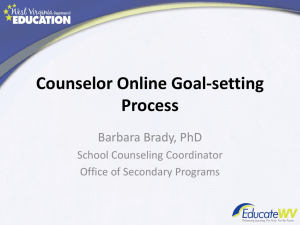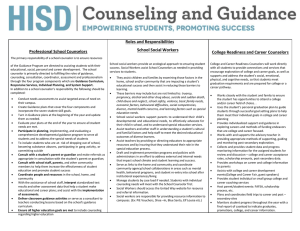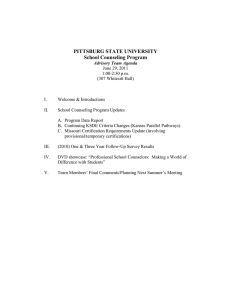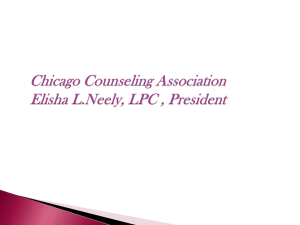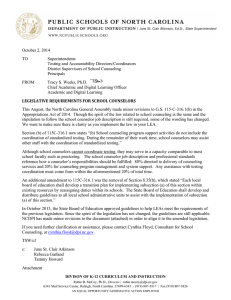The Impact of Cyber-Communication on Today`s Youth
advertisement
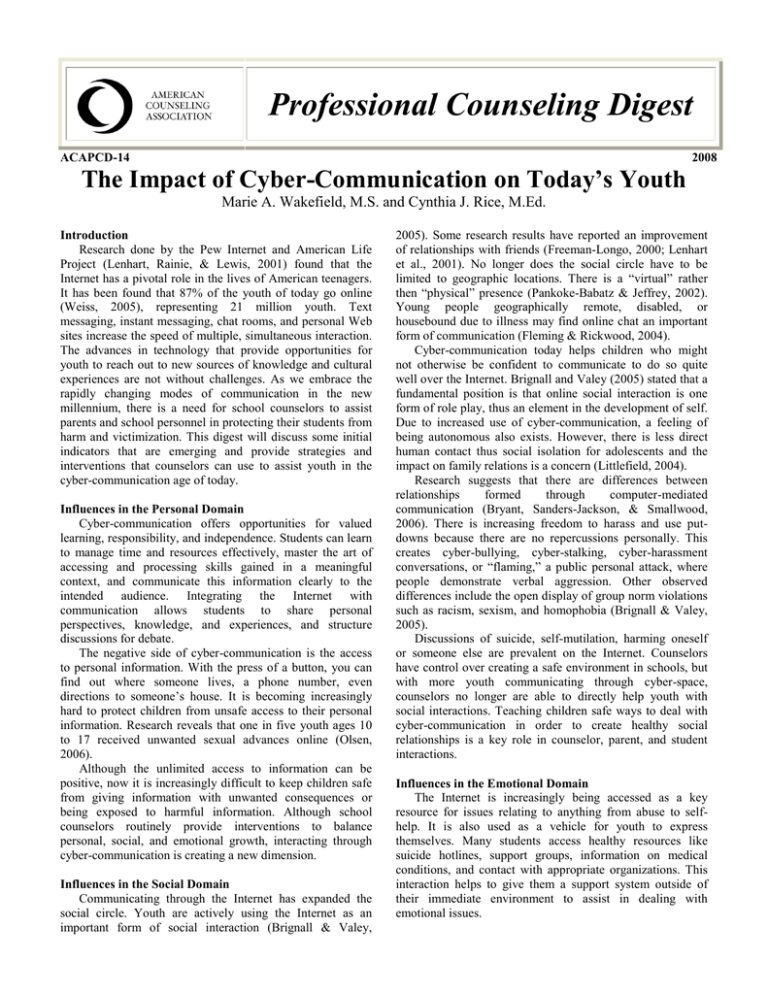
Professional Counseling Digest ACAPCD-14 2008 The Impact of Cyber-Communication on Today’s Youth Marie A. Wakefield, M.S. and Cynthia J. Rice, M.Ed. Introduction Research done by the Pew Internet and American Life Project (Lenhart, Rainie, & Lewis, 2001) found that the Internet has a pivotal role in the lives of American teenagers. It has been found that 87% of the youth of today go online (Weiss, 2005), representing 21 million youth. Text messaging, instant messaging, chat rooms, and personal Web sites increase the speed of multiple, simultaneous interaction. The advances in technology that provide opportunities for youth to reach out to new sources of knowledge and cultural experiences are not without challenges. As we embrace the rapidly changing modes of communication in the new millennium, there is a need for school counselors to assist parents and school personnel in protecting their students from harm and victimization. This digest will discuss some initial indicators that are emerging and provide strategies and interventions that counselors can use to assist youth in the cyber-communication age of today. Influences in the Personal Domain Cyber-communication offers opportunities for valued learning, responsibility, and independence. Students can learn to manage time and resources effectively, master the art of accessing and processing skills gained in a meaningful context, and communicate this information clearly to the intended audience. Integrating the Internet with communication allows students to share personal perspectives, knowledge, and experiences, and structure discussions for debate. The negative side of cyber-communication is the access to personal information. With the press of a button, you can find out where someone lives, a phone number, even directions to someone’s house. It is becoming increasingly hard to protect children from unsafe access to their personal information. Research reveals that one in five youth ages 10 to 17 received unwanted sexual advances online (Olsen, 2006). Although the unlimited access to information can be positive, now it is increasingly difficult to keep children safe from giving information with unwanted consequences or being exposed to harmful information. Although school counselors routinely provide interventions to balance personal, social, and emotional growth, interacting through cyber-communication is creating a new dimension. Influences in the Social Domain Communicating through the Internet has expanded the social circle. Youth are actively using the Internet as an important form of social interaction (Brignall & Valey, 2005). Some research results have reported an improvement of relationships with friends (Freeman-Longo, 2000; Lenhart et al., 2001). No longer does the social circle have to be limited to geographic locations. There is a “virtual” rather then “physical” presence (Pankoke-Babatz & Jeffrey, 2002). Young people geographically remote, disabled, or housebound due to illness may find online chat an important form of communication (Fleming & Rickwood, 2004). Cyber-communication today helps children who might not otherwise be confident to communicate to do so quite well over the Internet. Brignall and Valey (2005) stated that a fundamental position is that online social interaction is one form of role play, thus an element in the development of self. Due to increased use of cyber-communication, a feeling of being autonomous also exists. However, there is less direct human contact thus social isolation for adolescents and the impact on family relations is a concern (Littlefield, 2004). Research suggests that there are differences between relationships formed through computer-mediated communication (Bryant, Sanders-Jackson, & Smallwood, 2006). There is increasing freedom to harass and use putdowns because there are no repercussions personally. This creates cyber-bullying, cyber-stalking, cyber-harassment conversations, or “flaming,” a public personal attack, where people demonstrate verbal aggression. Other observed differences include the open display of group norm violations such as racism, sexism, and homophobia (Brignall & Valey, 2005). Discussions of suicide, self-mutilation, harming oneself or someone else are prevalent on the Internet. Counselors have control over creating a safe environment in schools, but with more youth communicating through cyber-space, counselors no longer are able to directly help youth with social interactions. Teaching children safe ways to deal with cyber-communication in order to create healthy social relationships is a key role in counselor, parent, and student interactions. Influences in the Emotional Domain The Internet is increasingly being accessed as a key resource for issues relating to anything from abuse to selfhelp. It is also used as a vehicle for youth to express themselves. Many students access healthy resources like suicide hotlines, support groups, information on medical conditions, and contact with appropriate organizations. This interaction helps to give them a support system outside of their immediate environment to assist in dealing with emotional issues. On the negative side, this ability to find resources regarding the emotional domain can be harmful. There are hemlock (suicide) societies on-line. There is information on how to build bombs, self-mutilate, be sexually active, participate in drug use, and many other illegal and illicit activities (Payne, 2006). Thirty percent of all adolescents have suicidal thoughts, and over half of them use the Web (Becker, Mayer, Nagenborg, El-faddagh, & Schmidt, 2004). Children are exposed to unhealthy emotional ideas and outlets that they otherwise would not be aware of until a more mature age normally (Becker et al., 2004). Strategies and Interventions for Counselors There are many strategies and interventions counselors can use today to deal with cyber-communication and helping youth. Counselors have to change the focus on dealing with youth and their needs in order to be effective in the 21st century. They must become cyber-counselors and use the Internet as an increasingly effective source of information. To stay current with information, it is vital that counselors use the Internet as a resource and teach students to use the Internet as a healthy resource of information. A counselor’s knowledge of cyber vocabulary/terminology is key to understanding communication on the Internet. Cyber-Safety is an important aspect of counseling today. It is important that counselors train parents and children to be aware of cyber-safety and to avoid victimization, including sexual solicitations and harassment. Teachers can integrate instruction into the curriculum and the classroom to address plagiarism, cheating, and other forms of unethical communication methods. Cyber-Lessons are vital in the classroom and in the counselor’s office. Those lessons may include: critiquing an instant/text message or an email to understand the message/messenger, discussing “netiquette,” reviewing appropriate use of MySpace.com, reading various pieces written for expression of poetry or other literary forms on blogs, and demonstrating the use of software with positive benefits. Counselors need to take advantage of those “teachable moments” (Freeman-Longo, 2000). Cyber-Helpers are an essential part of counseling for today and in the future. Training is essential for establishing a partnership between the counselor and students. It is not possible to monitor all of the social interaction and communication that happens on the Internet or cellular phones. It is the children who have access and are exposed to the communication going on outside the school walls on a daily basis. Students are a great network resource for informing school personnel if someone talks about suicide, harming others, or is participating in cyber-bullying. It is important to teach and model for our youth how and why to get “unplugged.” In this age of ever increasing electronic usage, from cellular phones to computers to iPods to video games, it is vital to bring back human social interaction. Balancing the “virtual” world with the “real” world can be the greatest gift of all. Cyber-communication may change many aspects of our lives—private, social, cultural, economic, and intellectual. However, with proper instruction, guidance, and supervision, there is the potential for the impact of positive, personal growth. References Becker, K, Mayer, M., Nagenborg, M., El-faddagh, M., & Schmidt, M. H. (2004). Parasuicide online: Can suicide websites trigger suicidal behaviour in predisposed adolescents? Nord J Psychiatry, 58(2),111-114. Brignall, T.W., III, & Valey, T. V. (2005). The impact of Internet communication on social interaction. Sociological Spectrum, 25, 335-348. Bryant, J. A., Sanders-Jackson, A., & Smallwood A. M. K. (2006). IMing, text messaging, adolescent social networks. Journal of Computer-Mediated Communication, 11(2), article 10. Fleming, M., & Rickwood, D. (2004). Teens in cyberspace. Youth Studies Australia, 23(3). Freeman-Longo, R. E. (2000). Children, teens, and sex on the Internet. Sexual Addiction and Compulsivity, 7, 75-90. Lenhart, A., Rainie, L., & Lewis, O. (2001, June 20). Teenage life online: The rise of the instant- message generation and the internet’s impact on friendships and family relationships. Washington, DC: Pew Internet and American Life Project. Littlefield, L. (2004, November 3). Psychosocial aspects of mobile phone use among adolescents. Melbourne: The Australian Psychological Society. Olsen, S. (2006). Keeping kids safe on social sites. Retrieved July 17, 2006, from CNET News.com. Pankoke-Babatz, U., & Jeffrey, P. (2002). Documented norms and conventions on the internet. International Journal of Human-Computer Interaction, 14(2), 219-235. Payne, J. W. (2006, July 4). Invitation to harm. The Washington Post, F-1. Weiss, D. L. (2005, August 11). Youth & the Internet. Focus on the Family. Marie A. Wakefield, M.S., is currently a doctoral student in school counseling, Past President of the American Counseling Association, and a consultant. Cynthia J. Rice, M.Ed., is a consultant and has been a school counselor in Hawaii and Las Vegas for eighteen years. Note. Adapted from Empowering the 21st Century Professional School Counselor, by J. Allen. (Ed.) (in press), Ann Arbor, MI: Counseling Outfitters, LLC. Copyright (in press) by Counseling Outfitters, LLC. Adapted with permission. ACA Professional Counseling Digests are produced by Counseling Outfitters, LLC, in collaboration with the American Counseling Association. Copyright 2008 American Counseling Association. Suggested APA style reference: Wakefield, M. A., & Rice, C. J. (2008). The impact of cyber-communication on today’s youth (ACAPCD-14). Alexandria, VA: American Counseling Association.
